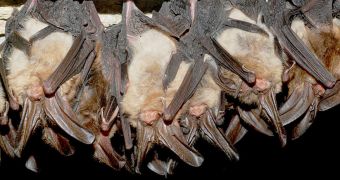Scientists involved in the desperate attempt to protect the endangered Virginia big-eared bats from extinction recently admitted that they have their work cut out for them. These animals are under threat from a very potent fungal infection, which at this point has no viable cure. Researchers say that it acts by awakening the winged creatures from their hibernation. In turn, this weakens them, and renders them unable to go out and look for food. They eventually die of starvation, and the White Nose Syndrome (WNS), as the condition is called, is ravaging colony after colony with nearly-maximum efficiency, Wired reports.
According to official statistics, more than 1 million bats in the United States have been killed off by this incredibly efficient pathogen within the past three years. As a result of this, experts decided to move some 40 of the creatures to the Smithsonian National Zoo, to be preserved in captivity. But these efforts are not going so well, when considering that only 11 of the original lot are still alive today. “We were not under the illusion that it was going to be easy. It’s certainly not a surprise to us that the bats died. But the number of bats that died is greater than we had hoped,” explains US Fish and Wildlife Service White Nose Syndrome coordinator, Jeremy Coleman.
At this point, it is estimated that only an approximate 15,000 Virginia big-eared bats still live in the open. While this number is considerably larger than the one recorded in 1979, of just 3,500, it is still dramatically below historical ones. Bats play a very important part in the ecosystem, cleaning it of various insects, that otherwise multiply out of control and become pests. Congress has allotted some $1.9 million to investigations into WNS, but thus far $300,000 have already been spent on the preservation effort with little success. The disease was first discovered in a cave in upstate New York, but it has now spread as far as the state of Tennessee, cleaning off colonies with nearly 100 percent efficiency along the way.
“There were many scientists who didn’t think it would work at all, and are philosophically opposed to captive bat populations anyway. The other school of thought is that desperate times call for desperate measures. If this species was going to get WNS, and if you didn’t start an intervention now, you’d never have a chance,” says National Speleological Society WNS liaison, Peter Youngbaer. “There are so few members of that species left. With the captive colony, the thought was, let’s see see if we can get this to work. And then we’ll have done what we can to save them. At least we won’t have regrets for not having tried,” he concludes.

 14 DAY TRIAL //
14 DAY TRIAL //